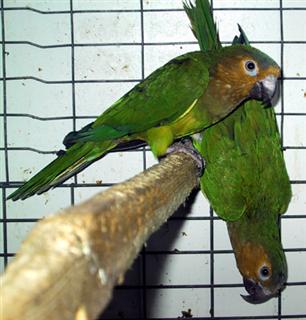Conure - St, Tomas
Brown Throat Conure Scientific Name: Aratinga pertinax pertinax
Sun, 1st June, 2025 - 8:20 pm GMT
Sponsor Ads:

Alternative Name
Brown Throat Conure Scientific Name: Aratinga pertinax pertinaxBasic Info
St. Thomas Conures average 10 inches (25 centimeters) in length at maturity. Though there are many subspecies, with different color variations, this subspecies, like the others has mostly green feathers. The ring around the eye area is white, with the iris being yellow. The bill of the St. Thomas Conure is black. The young Conures have a lighter color bill on top, and brown cheeks. The throat area, as well as the upper breast is usually an olive brown. Immature individuals have a green breast. They have blue crowns, with yellowish orange plumage covering other parts of the head. The lower breast has yellowish tints, with the abdomen turning orange. The tips of the primary feathers on the St. Thomas Conure are blue, and the underside of the wings range from an olive green to yellow, as does the underside of the tail. The feet are grey.
Health
When feeding the St. Thomas Conure, it is always best to offer either a formulated pellet diet or a fortified seed diet. As with most parrots, always offer them fresh fruits and vegetables, as well as foods such as beans and cooked eggs. Fresh water daily is necessary, as is removing fresh food quickly so it does not spoil. The St. Thomas Conure only needs a vitamin supplement if on a strictly seed diet. The size of the cage should be sufficient to accommodate their wings and room to play. Usually, an 18" by 18" by 22" wide cage will do, but larger cages are even better. A variety of perches is good exercise for the St. Thomas Conure's feet, and make sure the food dishes are not directly below a perch, so the food and water is not soiled. Toys are a must, since Conures are good chewers. In addition add a dish for bathing. If a bathing dish is not provided they should be showered regularly. Breeding Breeding among the St. Thomas Conures usually happens between February and September. The female will need a nesting box, with good nesting material, cork being a good choice. Make sure the entrance hole in the box is about 3 inches in diameter. If your St. Thomas Conure is using the nestbox for sleeping, that is a good sign. They usually have to get used to it before laying an egg. The clutch will have from 3 to 6 eggs that incubate approximately 23 day. The young Conures usually fledge after 50 days. The young ones will sometimes stay with their parents, even after leaving the nest. St. Thomas Conures can have several clutches a year.Habitat
The St. Thomas Conure likes dry scrubland, including cactus and acacia trees as well as some tropical areas.Behavior
St. Thomas Conures, also known as Brown Throated Conures, are medium sized parrots, with many color variations. St. Thomas Conures are intelligent, and both the male and the female are capable of talking. They have a reputation for being loud, and this should be considered before purchase. For this reason they may not be well suited for apartment living. Hand raised, well-socialized individuals are known for being very affectionate and loving pets, especially if they join your family while they are still young. They may, however, become nippy if they are not socialized well. Additionally some may become territorial with their cages, and this is another reason for frequent handling and socialization. The St. Thomas Conure should be given plenty of toys and stimulation to avoid boredom. They may become destructive if they are not given enough stimulation. The St. Thomas Conure has a tendency to bond with one particular member of the family over the rest. In addition to their talking abilities, these intelligent Conures have even been known to learn tricks. Their high levels of intelligence may help to explain why they become easily bored if they are not interacted with often. As with most Conures, the St. Thomas Conure loves to take a bath.Origin
St. ThomasHistory
St. Thomas Conures come from St. Thomas, the Virgin Islands and St. Croix. They usually travel in pairs, but have known to congregate in groups of as many as a hundred. While feeding, some of the Conures will watch for danger and alert the rest of the flock.Common Foods
N/ASponsor Ads:
Murphy's Law, Version No. 21: The secret of success is sincerity. Once you can fake that, you have it made.
Conure - St, Tomas
Coded by: BGID® | ALL RIGHTS RESERVED Copyright © 2000-2025
Disclaimer | Privacy | Report Errors / Contact | Credits

 President of the United States of America - Real Estate mogul, Pageant owner and now one of the most controversial men in political history.
President of the United States of America - Real Estate mogul, Pageant owner and now one of the most controversial men in political history.  Politician, US Vice President and President of the USA - Joseph Robinette Biden Jr.
Politician, US Vice President and President of the USA - Joseph Robinette Biden Jr.  versus
versus  Russia: 'The Evil Empire'? Are they all that bad or is it just the USA trying to portray Russia as bad because they are a world power with land bigger and a society very different from the USA ideal?
Russia: 'The Evil Empire'? Are they all that bad or is it just the USA trying to portray Russia as bad because they are a world power with land bigger and a society very different from the USA ideal?  Global warming has been in and out as the "latest" hot topic for many years. It is, according to modern scientists, the result of man-made industrial pollutants, clearing forested areas, agriculture, etc. But now they are thinking it started way before the Industrial Revolution...
Global warming has been in and out as the "latest" hot topic for many years. It is, according to modern scientists, the result of man-made industrial pollutants, clearing forested areas, agriculture, etc. But now they are thinking it started way before the Industrial Revolution... 
 Corona virus
Corona virus 
 Users with wide screen monitors can benefit from more content on every page.
Users with wide screen monitors can benefit from more content on every page.